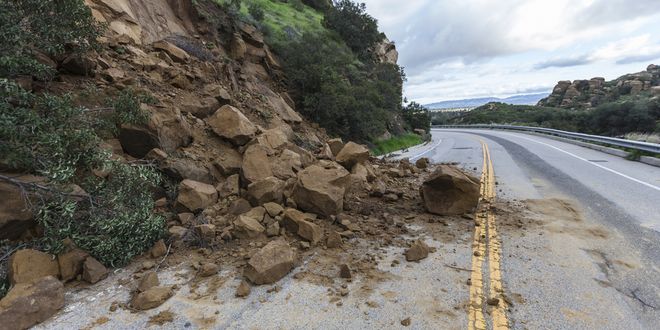Experts say landslides are an ever-increasing danger as climate-change brings bigger wildfires and shorter, intense rainstorms.
The Inland region of Southern California, with its hilly and mountainous terrain, and massive population growth, has become increasingly susceptible to devastating mudslides and landslides. These incidents leave wrecked homes, cars, and commercial buildings in their wake and even damage and close major thoroughfares like main arterials streets and highways.
Earlier this year, Highway 38 was covered by a landslide near Big-Bear. The highway was closed between Lake Williams and Forest Falls when trees, mud, rocks, and other debris inundated the road causing several vehicles to get stuck. Caltrans crews cleared the highway, but with the roadway still muddy, escorts were provided to drivers until the morning after the closure. The route was opened the following day.
Just before Christmas in 2017 in Highland, people were chased from their homes by walls of mud and water, leaving behind dwellings strung with holiday lights. They returned to find their neighborhood buried. Later five homes were deemed destroyed, and dozens of others were damaged.
Things took a deadly turn in 2003 on Christmas Day when mudslides and flooding swept away five adults and nine children at St. Sophia Camp near Crestline. Mudslides and flooding killed two others in a separate incident at a KOA campground in Devore when mudslides caused by massive rains swept through the area.
The combination of devastating forest fires that strip the land of the elements stitching it together followed by massive short burst rainstorms, is a recipe that is often repeated in Inland Southern California, and it is the perfect recipe for mudslides and landslides.
According to local experts, both mudslides and landslides can be extraordinarily devastating but are distinct in their causes.
“Landslides are caused by disturbances in the natural and underlying stability of a slope. They can accompany heavy rains, earthquakes, or other natural disasters but can also be man-made by poor construction and foundation work,” said Dale Scheffler, Owner and CEO of D.J. Scheffler & Nye. “Mudslides develop when water rapidly accumulates in the ground and results in a surge of water-saturated rock, earth, and debris.”
D.J. Scheffler & Nye is a recognized expert in the field of earth shoring, deep-foundation work, and mudslide and landslide abatement and repair. “The hillsides of Southern California are where I do much of my work and what really got me started in the business. We even created our own drilling rigs that would work better in those hilly environments,” said Scheffler. “Hillsides are notoriously difficult to build upon but often offer some of the best views and are coveted by homeowners and developers. We have been shoring and building foundations on those hills for more than forty years.”
According to a recent report by the United States Geological Survey, things are going from bad to worse in Southern California. The results show Californians are now facing a double whammy of increased wildfire and landslide risk caused by climate change-induced shifts in the state’s wet and dry seasons, according to researchers who mapped landslide vulnerability in the southern half of the state.
“This is our attempt to get people thinking about where these hazards are going to occur before there’s even a fire,” said Jason Kean, a hydrologist at USGS in Denver and lead author of the new study in AGU’s journal Earth’s Future. The journal publishes interdisciplinary research on the past, present, and future of our planet and its inhabitants. “By proactively thinking about hazards, you can start to develop more detailed response plans for their inevitability.”
Wildfires make the landscape more susceptible to landslides when rainstorms pass through as the water liquefies unstable, dry soil and burned vegetation. Geologists routinely conduct landslide hazard assessments after wildfires occur. Still, Kean said there is often not enough time between a fire and a rainstorm to implement an effective emergency response plan.
In the new study, Kean and his colleagues combined historical fire, rainfall, and landslide data with computer simulations to forecast where post-wildfire landslides are likely to occur in Southern California, how significant those landslides might be, and how often they can be expected to happen. Their goal was to map which regions of the state are most vulnerable to landslides before they happen, in a manner similar to how geologists map earthquake hazards.
“Although the growth in California is slowing (in fact, we lost population for the first time year over year in 2020), the demand for new housing is not nearly being met,” said Jay Prag, lead-economist and professor of economics and finance at The Drucker School. “Development is being pushed further and further out into the hillsides and forested areas. I don’t see any way in which the problem does not get worse in terms of the billions of dollars in property damage that will be done over the years.”
“Hence, one thing for sure, you expect higher rates for homeowners insurance is likely in California.”
 IE Business Daily Business news for the Inland Empire.
IE Business Daily Business news for the Inland Empire.


